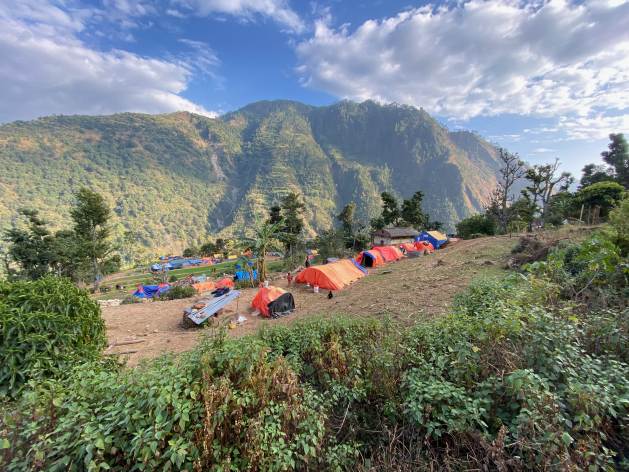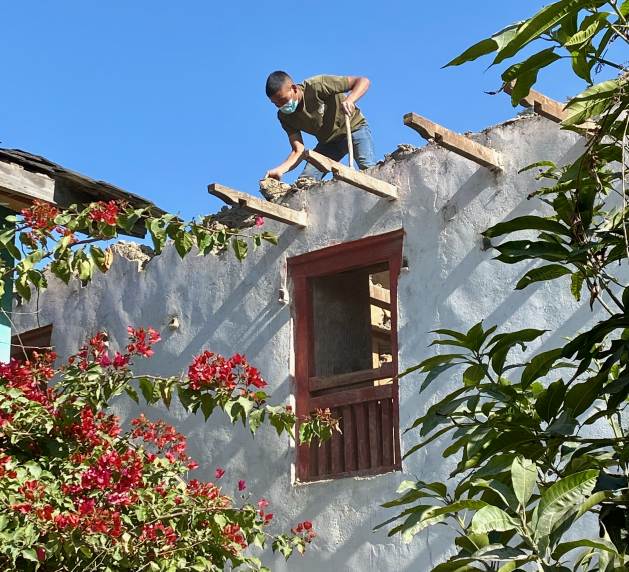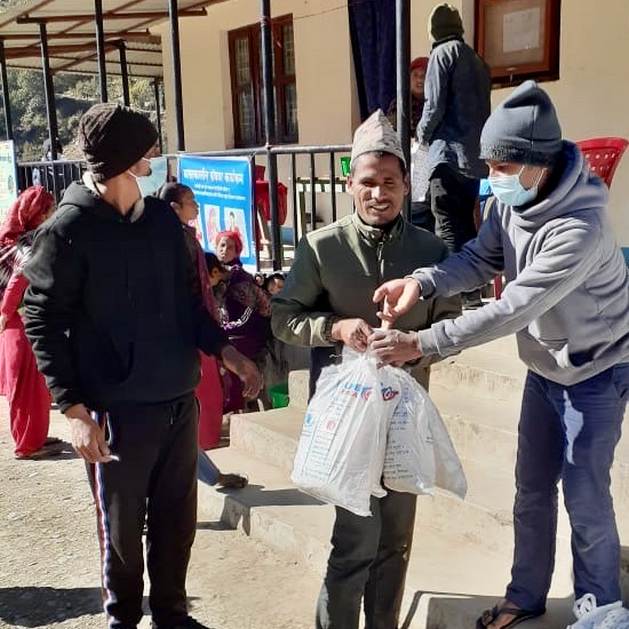Humanitarian Cash Not Accelerating Aid Delivery in Nepal's Earthquake Response

JAJARKOT DISTRICT, Nepal, Jan 16 (IPS) - Delivering humanitarian assistance in the form of cash sounds great: recipients get to choose exactly how to spend their money and aid organizations can respond faster and better track their giving.
But in Nepal, more than two months after a major earthquake killed more than 150 people and destroyed or damaged over 60,000 homes, what’s known as cash and voucher assistance (CVA) continues to play a minor role in the country’s disaster response.
CVA distribution “should have started in a few days, seven at most,” says Safik Iraqi, Inter-agency Cash Coordinator of the international community’s Cash Coordination Group (CCG) in Nepal, “but it took 47 days.”
“The more delays there are the more negative coping strategies the affected people will use,” adds Iraqi in an interview. These include:
- borrowing from local moneylenders
- buying poorly made items that won’t last, and
- selling household assets to raise money for necessities.
To date, an estimated 9,000 households in Jarkot and 10 surrounding districts in Karnali Province have received some sort of CVA, while the vast majority of people have received at least minimal aid in-kind, such as food, blankets and warm clothing.
November’s disaster was less destructive than the deadly 2015 earthquake and aftershocks, which killed about 9,000 people and damaged or destroyed 600,000 buildings. Cash transfers then “were a major and highly appropriate part of the response given the challenging logistics of delivering in-kind aid to remote mountainous areas,” found one report.
2015 response promising
But the analysis pointed out that the Government of Nepal and partners were not sufficiently prepared to use cash to its full potential. “This was due to a lack of government will and capacity, appropriate national disaster institutions, financial infrastructure and effective coordination arrangements among international actors.”
“While there has been some progress towards being able to mount better, more efficient and large-scale cash responses in the future, cash preparedness still remains too low a priority in Nepal given the disasters that will continue to affect the country,” concluded the report.
CVA actually refers to a variety of ways of getting money and goods into the hands of recipients, explains Bibhor Kayastha, chief executive officer of Aria Technologies, a private-sector business working with Mercy Corps.
These include multipurpose cash assistance (with few or no restrictions on how it can be used), sectoral cash (designated for a specific purpose, like building a house), conditional cash (given for work, such as road building), vouchers that can be exchanged for a package of commodities and other vouchers that limit people to items on a list. Various modalities are being used in Jajarkot and other affected districts, he adds in an interview.
The 3 November quake struck on the cusp of winter in Karnali Province, one of Nepal’s most remote and poorest areas, forcing many families into tents or simple plastic shelters. At least three dozen people have reportedly died since then, in part due to exposure.
On 6 November the Government of Nepal approved the distribution of one month’s CVA to affected households. Based on a basket of consumer goods, it is worth 15,000 rupees, or about US$112.

Ongoing scepticism
One reason for the delay getting that money to quake victims was that some of the 8-10 agencies that considered using CVA were waiting for a market assessment to be finished, says Iraqi in an interview. Another is ongoing scepticism, among both the international community and officials in Nepal’s three levels of government — central, provincial and local — that CVA will be well used.
The CCG’s Joint Market Assessment Report, #1 found that in both hardest hit districts, Jajarkot and neighbouring Rukum West, cash assistance was a priority among just slightly more than 1% of respondents. Temporary shelter / house reconstruction, warm clothes and blankets, and food topped both lists.
The Nepal Red Cross Society’s CVA was delayed because it had to provide immediate emergency aid, then do a detailed assessment of possible beneficiaries, says Sagar Shrestha, head of disaster management at the NRCS.
“We had to evaluate 30,000 households. It was really challenging but we had very clear instructions from local governments about which populations to focus on. We did detailed data collection, with various indicators to identify the most vulnerable, such as pregnant women and the elderly. Out of these we selected the beneficiaries then we did a community engagement to get those names endorsed, and then we posted the lists publicly for feedback,” he explains in a WhatsApp interview.
Dinesh Chaudhary’s wife died in November of an illness unrelated to the earthquake. While a hospital that treated her for over a month has erased his bills, and he’s borrowed from family and friends, he’s still in debt for her care. “Yes, 15,000 rupees would be useful. If they offer it we have to take it, no?” he tells IPS, sitting outside of his cracked mud and brick house in Nalgad Municipality, Jajarkot.
Many of the small houses nearby have been visibly damaged, either completely crumbled or with only their bottom floor impact. The green and brown hillsides of this mountainous region are dotted with clusters of blues and yellows that signal relief tents.
The UN World Food Programme (WFP) was one of the first organizations to provide CVA. It distributed the aid to 3,055 households in Jajarkot and Rukum West as multi-purpose cash assistance, which could be spent as recipients’ wished.

Money transfer established
More than two-thirds of the cash was transferred via money transfer operations, which normally cater to the families of local workers who migrate from Nepal to work as labourers in India, Malaysia or Gulf countries. In other cases, money was sent via local banks.
Households with members from vulnerable or marginalized groups were prioritized, says WFP. They included Lal Bahadur, 36, who lives with a disability in Jajarkot. “I am here to receive nutritious food for my pregnant wife and daughter-in-law, who is nursing my 15-day-old grandson, ” he told WFP.
The agency says that cash-based transfers now make up 35 percent of all its assistance globally. “Evidence accumulated over the past decade shows that in most contexts cash effectively and efficiently meets people’s food, nutrition and other related essential needs,” adds WFP.
But in Nepal, the advantages of cash are slow to be realized.
“Most people in Nepal think that CVA is ‘easy money’,” says Kayastha. “But the process is highly technical and controlled by things like Central Bank regulations, the Data Protection Act, and environmental factors that have to be taken into consideration.
“A lot of misinformation”
“The general perception,” he adds, “is that people will waste the money. But if you give it to the right person they will never go and drink (with it)… there is a lot of misinformation and even major stakeholders will just dismiss (CVA).”
Iraqi says the combination of traditional mindsets and a lack of awareness about how efficient and effective CVA can be are major obstacles to expanding. “In my experience the units in charge of implementation disaster response are very much in favour but the rest are very much against it.”
“There is a need for the government to understand the global standards used for CVA, its meticulousness, the evolution in technology for delivering CVA and the importance of a harmonized and coordinated approach. This will help it to see how CVA works in the humanitarian response works and how misuse (their biggest concern) can be tracked and addressed,” adds Iraqi.
Another reason for CVA’s slow penetration is the ‘power game’ that is constantly played between Nepal’s political parties, often most actively outside the capital Kathmandu. In it, scoring political points is more important than “giving choice and dignity and quality of life, which is very frustrating for organizations and people like us,” said one interviewee, who asked to remain anonymous.
Officials are slowly accepting CVA, says Santosh Pandey, country humanitarian focal point at Mercy Corps Nepal. “The government doesn’t always mean the federal government – many local governments have formulated very progressive humanitarian cash guidelines.”
No one from the Government of Nepal was available for an interview for this article. The ministry of federal affairs and general administration is now drafting a policy on CVA for Nepal’s 77 local governments.
© Inter Press Service (2024) — All Rights Reserved. Original source: Inter Press Service
 Global Issues
Global Issues